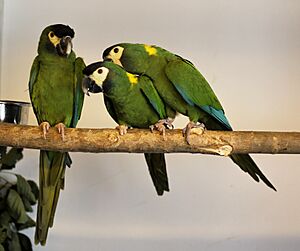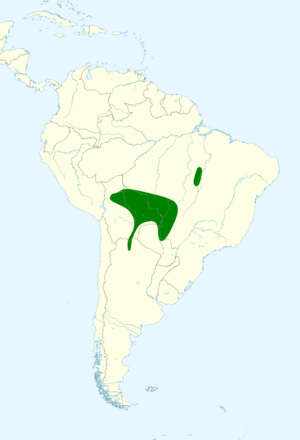Golden-collared macaw facts for kids
Quick facts for kids Yellow-collared macaw |
|
|---|---|
 |
|
| Conservation status | |
| Scientific classification | |
| Genus: |
Primolius
|
| Species: |
auricollis
|
 |
|
The Yellow-collared macaw (Primolius auricollis) is a small, mostly green parrot from Central South America. It's part of a big family of parrots called macaws. This bird gets its name from a bright yellow patch that looks like a collar on the back of its neck. People sometimes call these smaller macaws "mini-macaws."
Contents
About Its Name
Scientists give every animal a special name. The Yellow-collared macaw was first described by an American scientist named John Cassin in 1853. Some people even called it Cassin's macaw! Its scientific name, auricollis, means "gold-collared." This comes from the Latin words aurum (gold) and collum (neck).
What Does It Look Like?
This macaw is about 38 centimeters (15 inches) long. Almost half of that length is its long tail feathers! Most of its body is green. It has a clear yellow "collar" that is widest on the back of its neck. This yellow collar becomes brighter as the bird gets older.
The front of its head and its crown are brownish-black. The main flight feathers on its wings are blue. The long, pointed tail has a red base, a thin green middle, and a blue tip. The underside of its tail and flight feathers are greenish-yellow. Its legs are a light pinkish color, and its eyes are reddish to dull yellow. It has a lot of bare white skin on its face. Its strong beak is black, sometimes with a pale gray tip.
Where Do They Live?
Yellow-collared macaws live in several countries in South America. You can find them in parts of Brazil, northern Argentina, northern Paraguay, and most of northern and eastern Bolivia. There's also another group living in a different part of Brazil.
They like to live in forests, woodlands, and grasslands with scattered trees. They usually live in low areas, but sometimes they can be found up to 1,700 meters (about 5,600 feet) high. They avoid the thick Amazon Rainforest.
Conservation Status
Good news! The Yellow-collared macaw is quite common. Because of this, experts consider it a species of "least concern." This means they are not currently in danger of disappearing. However, they are listed in CITES Appendix II. This means that if people want to trade them, they need special permits to make sure it's done safely and legally.
Behavior and Temperament
In the wild, you'll often see these macaws in pairs. When it's not breeding season, they might gather in small groups.
As a Pet
Yellow-collared macaws can be wonderful pets. They are very social and love attention from their owners. They usually need about three to four hours of interaction every day. If they are well cared for, they can live for up to 50 years!
These macaws are known for being smart and a bit mischievous. They enjoy getting attention and will try to get it in any way they can! They need a large cage with lots of toys because they can get bored easily. They can also learn to say many words. While they can be very loving, they might be a bit unpredictable with children. If they don't get enough attention, they can sometimes become aggressive.
What Do They Eat?
Yellow-collared macaws eat fruits, flower buds, and seeds.
Reproduction and Life Cycle
Yellow-collared macaws build their nests in holes inside trees. The female usually lays two or three white eggs. She sits on the eggs for about 26 days to keep them warm. After the chicks hatch, they stay in the nest for about 70 days before they are ready to fly out on their own.
See also




